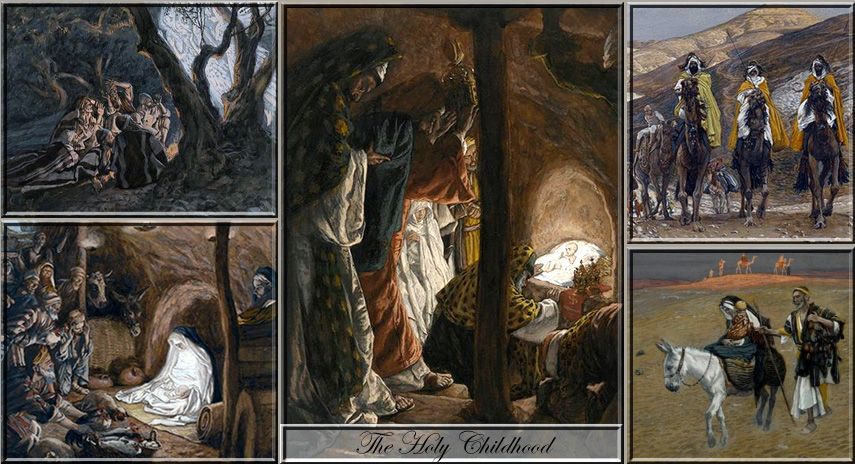
From the Latin Vulgate with Illustrations by James Tissot, 1899 Volume 1: Part One
We now present Tissot's work, The Life of Our Savior Jesus Christ, with Part I of Volume 1 entitled The Holy Childhood. While not limited exclusively to the Nativity of Jesus, this selection from Sacred Scripture makes for a wonderful peparation for Christmas during the season of Advent. Below is a small excerpt from the text which takes us to Bethlehem on Christmas night:
"It is three days' walk, by the direct road from Nazareth to Bethlehem; and if you go by way of Jerusalem, four days are required.
"The travellers summoned to be taxed by the decree of Caesar Augustus, when Cyrenius was Governor of Syria, must have been very numerous, and the one caravansary the town could boast, must have been quite insufficient to accommodate them all. As a matter of fact we must understand by the "diversorium" used in the Vulgate, a simple caravansary and not a regular hostelry properly so called, such as is implied in most French translations of the Gospels. The sort of establishment to which we apply the term of hostelry, or inn, would have been altogether foreign to the Oriental usages of the time under notice and this is still very much the case.
"At the time of the Conquest of Palestine by Joshua, Bethlehem was, like Jerusatem, inhabited hy the idolatrous Canaanites, and in the division of the conquered districts, it fell to the lot of the tribe of Judah. "The situation of Bethlehem, moreover, is most beautiful. Built on the crest of the mountains of Judaea, about two leagues to the south of Jerusalem, its form is that of a crescent, one end of which is marked by the Wells of David, the other by the Grottoes of the Nativity. "Between the two horns of the crescent stretches a fertile valley, the Wady-el-Karoubeh. The descent of this valley is very steep, and resembles a circus, with low, parallel walls, which keep the earth from sliding down, representing the tiers of seats. This valley presents a most charming appearance, clothed, as it is, with an abundant vegetation, in which vines, fig, olive and almond trees abound. "The view from the top of the plateau is bounded on the north by the Hill of Mar-Elias, and on the west by the Mountains of the Desert where St. John dwelt. On the east, Beit-Saour rises from the little hill where Ruth gleaned the ears of corn in the field of Boaz, whilst beyond can be seen the sterile stony hills, called the Wilderness. Yet further to the east the rocks of Mount Moab stretch along like a wall, the base of which is bathed by the waters of the Dead Sea. On the south, Mount Herodion forms a regular cone, on the summit of which a few ruins indicate the site of the castle of Herod. It was here that the tetrarch was interred, and later, the Crusaders raised defensive works, hence its more modern appellation of the Hill of the Franks. "The Grottoes of the Nativity are a series of natural caves, extending for a considerable distance in the mountains, forming chambers connected with each other. As a matter of fact, shepherds, watching their flocks on the hills, availed themselves of these shelters in cold or bad weather, and it was in them that Mary and foseph, finding no place in the caravansary, decided to take refuge. "The particular spot indicated by tradition is situated in the lower part of one of these caves, reached by two slopes, now converted into flights of stone steps. "Between the two sets of steps is a slight depression which tradition indicates as the spot to which Mary retired for the actual birth of the divine Child. "It was only after the birth that she carried Him a few paces further to a more commodious place, more sheltered from the cold, where it was possible to give the cave something of the semblance of a room. "There, says the legend, were some animals: an ox and an ass, but, however that may be, Mary found something there to serve the purpose of a crib, in which to lay her new-born child; this crib, or manger as it is generally called, is now preserved in the Church of Santa-Maria-Maggiore at Rome, where it is visited and venerated by numerous pilgrims. "The place rendered sacred by the birth of the Saviour naturally became a goal of pilgrimage. The early Christians flocked to it in crowds. After the revolt of the Jews, under Barcocheha, the Emperor Hadrian had a temple to Jupiter erected on the Mount of Olives, on the very scene of the Ascension; a temple to Venus, on Golgotha : and one to Adonis, above the Grottoes of Bethlehem. These three temples remained standing for one hundred and eighty years, thus providentially attesting the sites of these venerated sanctuaries, until the time when Saint Helena, mother of the Emperor Constantine, replaced them with basilicas, in honour of Jesus Christ. "The Basilica of Bethlehem is still standing, and with the exception of the facade, which is hidden by massive buildings, is almost intact. "Catholic Harbor has the following volumes of Tissot's The Life of our Savior Jesus Christ completed which you may access by clicking on the following links:
The Life of Our Savour Jesus Christ: Volume 1 Part2:
The Ministry of Jesus The Life of Our Savour Jesus Christ: Volume 3: Holy Week and the Passion of Jesus Christ The Life of Our Savour Jesus Christ: Volume 4 Part 1: The Passion Continued and the Death of Jesus Christ The Life of Our Savour Jesus Christ: Volume 4 Part 2: The Resurrection and Ascension of Jesus Christ
To download the entire book, click on the link below. Download the book, "The Life of Our Saviour Jesus Christ" http://catholicharboroffaithandmorals.com/ |
